There are plenty of options available when it comes to planting fodder or catch crops.
Many work as both.
If you are a tillage farmer with a livestock farmer nearby who might want to grow more fodder to free up other land, then it might be worth approaching that farmer to see if they would like to make an agreement with you to grow fodder and allow them to graze it. Likewise, a livestock farmer could ask a tillage farmer.
The tillage farmer could also benefit from having livestock in the rotation.
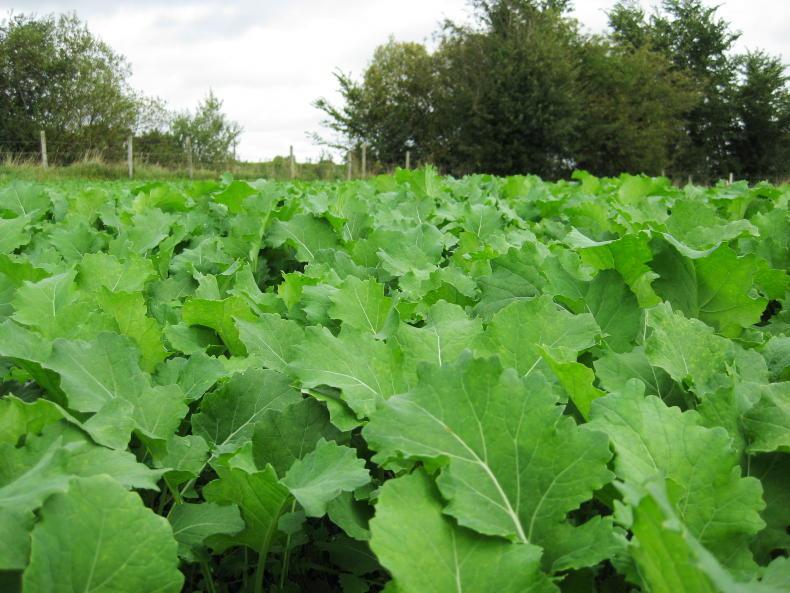
Fodder rape.
Fodder rape
Dry matter yield: 3.5t/ha to 5t/ha.Fresh yield: 25t/ha to 36t/ha.Dry matter content: 12% to 13%.Crude protein: 18% to 20%.Sowing rate: 10kg/ha when broadcast. Decrease if drilling.Advantages/disadvantages: research has shown it has helped to keep the ground driest in cover crop experiments. Helps to shade out weeds.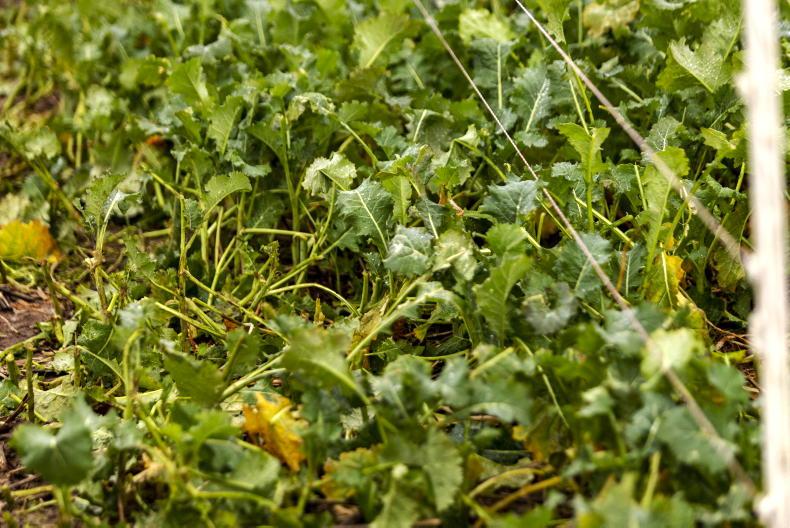
Hybrid fodder rape has good regrowth potential.
Hybrid fodder rape
Sowing rate: 10kg/ha, less if drilling.Advantages/disadvantages: has regrowth potential, high dry matter content, not as susceptible to mildew or club root as conventional fodder rape.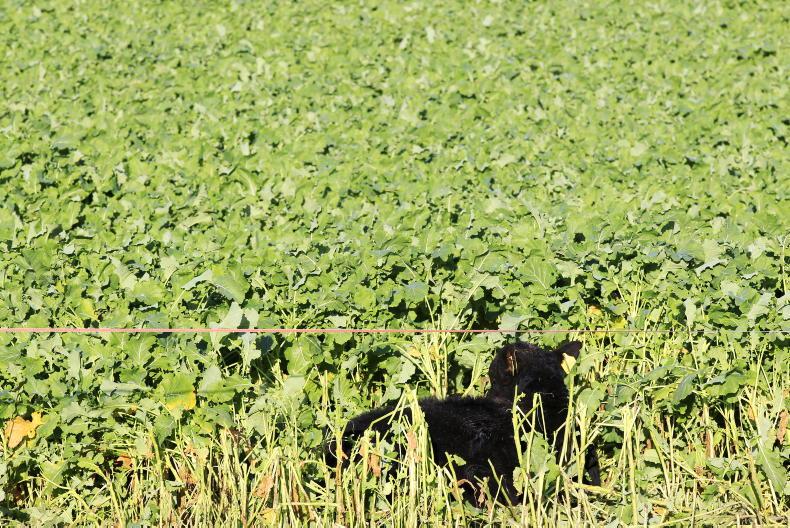
Kale.
Kale
Dry matter yield: 6t/ha to 9t/ha.Fresh yield: 40t/ha to 60t/ha.Dry matter content: 14% to 16%.Crude protein: 15% to 17%.Sowing rate: approximately 7kg/ha when broadcasting, down to 5kg/ha when drilling.Sowing date: up to middle of July, or late June in the north of the country.Advantages/disadvantages: not suited to sowing in July apart from where sowing conditions are very good. Needs a good seedbed. Often used to tidy up fields before reseeding.
Stubble turnips being measured for yield.
Stubble turnips
Dry matter yield: 3t/ha to 4t/ha.Fresh yield: 35t/ha to 40t/ha.Dry matter content: 8% to 9%.Crude protein: 17% to 18%.Sowing rate: 8kg/ha when broadcast and decrease for drilling.Advantages/disadvantages: can be grazed. Need to be sown early to get good growth and best utilisation. Roughage needed. Frost can damage the crop in the winter.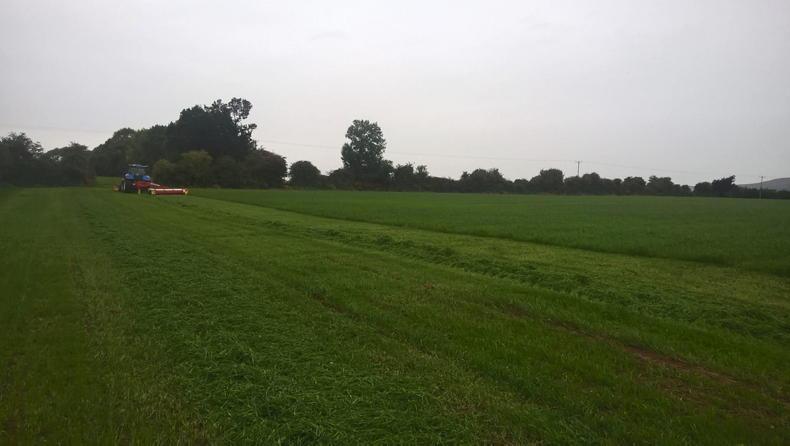
Westerwolds being mowed.
Westerwolds
Dry matter yields: 16t/ha to 20t/ha.Fresh yield: 90t/ha to 100t/ha.Sowing rate: 40kg/ha.Advantages/disadvantages: can be cut and grazed. Might get two to three cuts if sown early after a cereal crop. However, should not be let go to seed as weed seeds stay in the ground making grass weed control extremely difficult in tillage land.GLAS catch crops
If you are planting catch crops under the Green, Low-carbon, Agri-Environment Scheme (GLAS) then these crops can be grazed after 1 December each year. They must be planted by 15 September. A mix must be sown under this measure and it must contain at least two species at minimum seeding rates outlined under the measure. Mixes can include two or more species.
Fodder rape and leafy turnip mix
Sowing rate: will depend on the mix. Needs at least 3kg/ha to 5kg/ha of fodder rape and 5kg/ha of leafy turnip.Advantages/disadvantages: meets GLAS requirements. Maintains quality in the winter time. One of the lower-cost options. Not suited to crop rotations containing oilseed rape.When it comes to growing catch crops, which won’t be grazed or cut for livestock, there are a host of options and a host of different reasons to plant them.
Planting oats, for example, is low-cost and will help to take up nitrogen. Leguminous crops such as vetch, beans, peas and different clovers will all help to fix nitrogen from the atmosphere.

Phacelia is a good catch crop option.
Crops like phacelia are good at soil conditioning. They have fine roots and can help to improve soil structure.
Tillage radish has a deep root and can help to tackle compaction issues in fields.
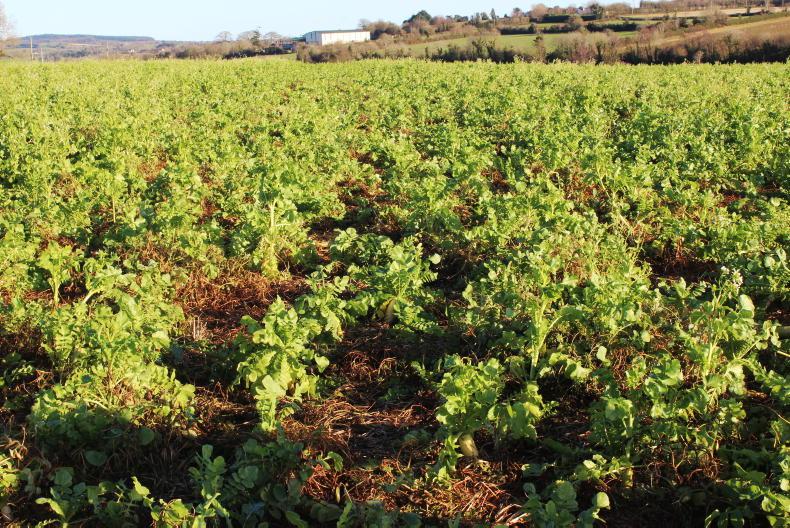
Tillage radish where peas and lupins have already been killed by frost.
All crops will help to take up soil nutrients that may be lost over winter and therefore allow fertiliser use to be cut somewhat in the following season.
These crops will help to increase soil organic matter and improve soil structure when grown and returned to the soil.

Berseem clover is a catch crop option.
These crops are really important for carbon sequestration. They take in carbon from the atmosphere and then help to store carbon in the soil.
Planting cover crops is one of the major factors helping to offset carbon emissions on tillage farms.
New research from Teagasc suggests that many Irish tillage farms may be carbon-neutral or even carbon-positive and catch crops are contributing to this.
There are plenty of options available when it comes to planting fodder or catch crops.
Many work as both.
If you are a tillage farmer with a livestock farmer nearby who might want to grow more fodder to free up other land, then it might be worth approaching that farmer to see if they would like to make an agreement with you to grow fodder and allow them to graze it. Likewise, a livestock farmer could ask a tillage farmer.
The tillage farmer could also benefit from having livestock in the rotation.

Fodder rape.
Fodder rape
Dry matter yield: 3.5t/ha to 5t/ha.Fresh yield: 25t/ha to 36t/ha.Dry matter content: 12% to 13%.Crude protein: 18% to 20%.Sowing rate: 10kg/ha when broadcast. Decrease if drilling.Advantages/disadvantages: research has shown it has helped to keep the ground driest in cover crop experiments. Helps to shade out weeds.
Hybrid fodder rape has good regrowth potential.
Hybrid fodder rape
Sowing rate: 10kg/ha, less if drilling.Advantages/disadvantages: has regrowth potential, high dry matter content, not as susceptible to mildew or club root as conventional fodder rape.
Kale.
Kale
Dry matter yield: 6t/ha to 9t/ha.Fresh yield: 40t/ha to 60t/ha.Dry matter content: 14% to 16%.Crude protein: 15% to 17%.Sowing rate: approximately 7kg/ha when broadcasting, down to 5kg/ha when drilling.Sowing date: up to middle of July, or late June in the north of the country.Advantages/disadvantages: not suited to sowing in July apart from where sowing conditions are very good. Needs a good seedbed. Often used to tidy up fields before reseeding.
Stubble turnips being measured for yield.
Stubble turnips
Dry matter yield: 3t/ha to 4t/ha.Fresh yield: 35t/ha to 40t/ha.Dry matter content: 8% to 9%.Crude protein: 17% to 18%.Sowing rate: 8kg/ha when broadcast and decrease for drilling.Advantages/disadvantages: can be grazed. Need to be sown early to get good growth and best utilisation. Roughage needed. Frost can damage the crop in the winter.
Westerwolds being mowed.
Westerwolds
Dry matter yields: 16t/ha to 20t/ha.Fresh yield: 90t/ha to 100t/ha.Sowing rate: 40kg/ha.Advantages/disadvantages: can be cut and grazed. Might get two to three cuts if sown early after a cereal crop. However, should not be let go to seed as weed seeds stay in the ground making grass weed control extremely difficult in tillage land.GLAS catch crops
If you are planting catch crops under the Green, Low-carbon, Agri-Environment Scheme (GLAS) then these crops can be grazed after 1 December each year. They must be planted by 15 September. A mix must be sown under this measure and it must contain at least two species at minimum seeding rates outlined under the measure. Mixes can include two or more species.
Fodder rape and leafy turnip mix
Sowing rate: will depend on the mix. Needs at least 3kg/ha to 5kg/ha of fodder rape and 5kg/ha of leafy turnip.Advantages/disadvantages: meets GLAS requirements. Maintains quality in the winter time. One of the lower-cost options. Not suited to crop rotations containing oilseed rape.When it comes to growing catch crops, which won’t be grazed or cut for livestock, there are a host of options and a host of different reasons to plant them.
Planting oats, for example, is low-cost and will help to take up nitrogen. Leguminous crops such as vetch, beans, peas and different clovers will all help to fix nitrogen from the atmosphere.

Phacelia is a good catch crop option.
Crops like phacelia are good at soil conditioning. They have fine roots and can help to improve soil structure.
Tillage radish has a deep root and can help to tackle compaction issues in fields.

Tillage radish where peas and lupins have already been killed by frost.
All crops will help to take up soil nutrients that may be lost over winter and therefore allow fertiliser use to be cut somewhat in the following season.
These crops will help to increase soil organic matter and improve soil structure when grown and returned to the soil.

Berseem clover is a catch crop option.
These crops are really important for carbon sequestration. They take in carbon from the atmosphere and then help to store carbon in the soil.
Planting cover crops is one of the major factors helping to offset carbon emissions on tillage farms.
New research from Teagasc suggests that many Irish tillage farms may be carbon-neutral or even carbon-positive and catch crops are contributing to this.













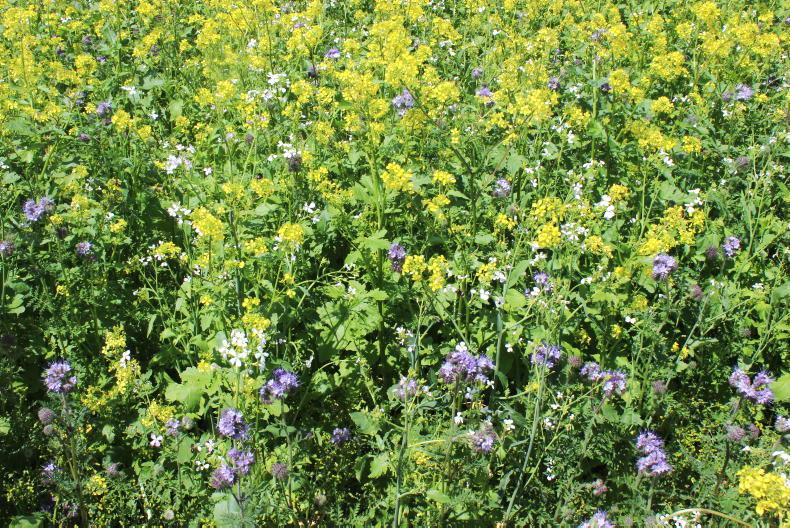

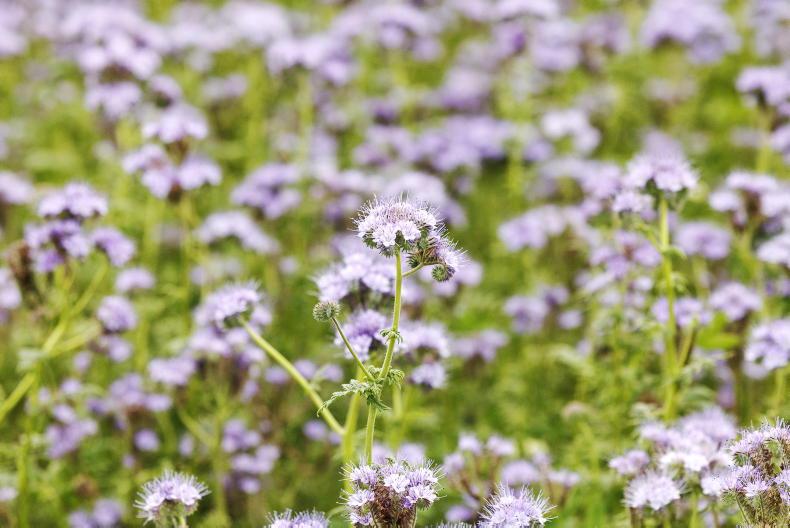
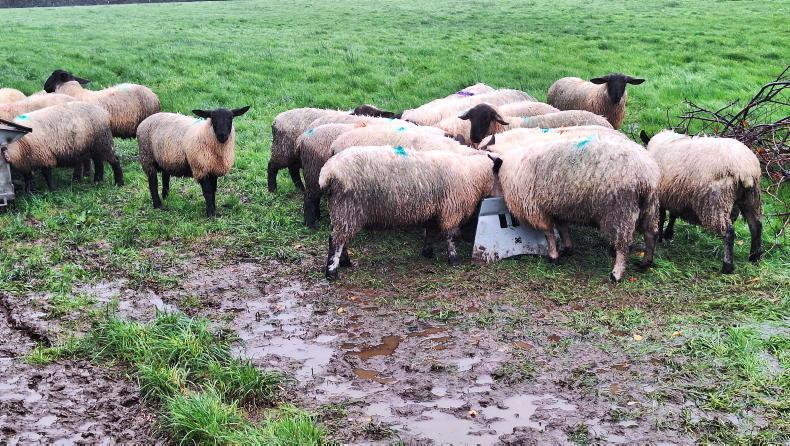
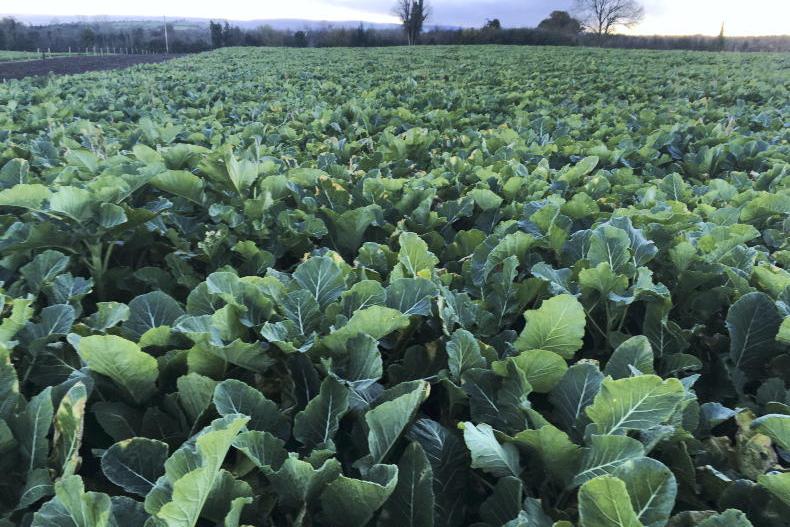
SHARING OPTIONS